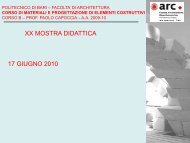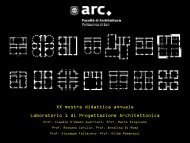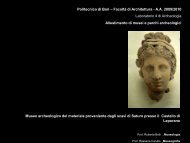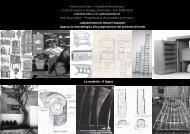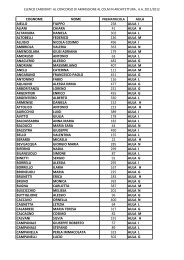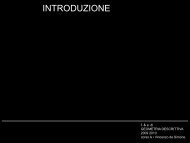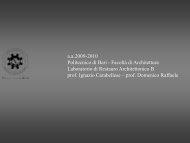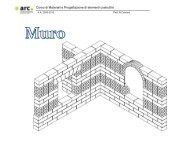Scarica il file pdf - Politecnico di Bari
Scarica il file pdf - Politecnico di Bari
Scarica il file pdf - Politecnico di Bari
You also want an ePaper? Increase the reach of your titles
YUMPU automatically turns print PDFs into web optimized ePapers that Google loves.
44. I regolamenti <strong>di</strong>dattici66The course w<strong>il</strong>l be preceded by a shortexcursus on the Egyptian and Orientalconstructive techniques, regarded asfundamental in order to comprise thesuccessive evolution of the Greek world.Articolazione delle attività <strong>di</strong>dattiche:Oltre alle lezioni ex cathedra, <strong>il</strong> corso prevededelle esercitazioni, durante le qual<strong>il</strong>’allievo sarà invitato a dedurre dall’osservazione<strong>di</strong>retta, me<strong>di</strong>ante schizzi e appuntigrafici, considerazioni sulle caratteristichecostruttive degli organismi esaminati. Altreesercitazioni saranno invece destinate allalettura critica e al commento <strong>di</strong> passi <strong>di</strong>autori antichi sul tema.Articulation of educational activities:Besides the ex cathedra lectures, thecourse includes practical exercises, duringwhich the student w<strong>il</strong>l be invited to deducefrom <strong>di</strong>rect observations, by means ofgraphical sketches and notes,considerations on the constructivecharacteristics of the architecturalorganisms examined. Other exercises w<strong>il</strong>lbe destined to the translation, criticalrea<strong>di</strong>ng and commenting of passages ofancient sources on the topic.Argomenti delle lezioniTecniche costruttive del mondo egiziano edorientale: costruzioni in terra, costruzioni inpietra. Lo sfruttamento delle cave. Ilcantiere: sistemi <strong>di</strong> sollevamento e <strong>di</strong>fissaggio.Tecniche costruttive del mondo greco:cenni sui materiali e le tecniche impiegatinel mondo minoico e miceneo. Il mondogreco classico ed ellenistico: la lavorazionedell’arg<strong>il</strong>la e le sue <strong>di</strong>verse applicazioni; laterracotta e l’introduzione dei tetti integole; la lavorazione del legno; lalavorazione della pietra e del marmo.L’organizzazione del cantiere: sistemi <strong>di</strong>fissaggio e <strong>di</strong> sollevamento. I <strong>di</strong>versi tipi <strong>di</strong>tessiture murarie e loro impiegonell’architettura greca.Tecniche costruttive del mondo romano etardo-romano: l’ere<strong>di</strong>tà del mondo grecoed ellenistico. I <strong>di</strong>versi tipi <strong>di</strong> tessituremurarie e loro impiego nell’architetturaromana. La creazione dell’opuscaementicium e le sue applicazioni. Losv<strong>il</strong>uppo dell’opus testaceum. L’impiegodell’opus testaceum come possib<strong>il</strong>eelemento <strong>di</strong> datazione delle strutturemurarie. Laterizi speciali e loro impiego neisistemi idraulicic e <strong>di</strong> riscaldamento/isolamento. L’organizzazione del cantiere:le fondazioni, i sistemi <strong>di</strong> sollevamento, leimpalcature. La <strong>di</strong>ffusione dei marmicolorati. Le cave <strong>di</strong> proprietà imperiale e lacircolazione dei manufatti in marmo. Lacircolazione delle maestranze Materiali etecniche per rivestimenti parietali epavimentali. L’evoluzione del mosaico. I<strong>di</strong>versi “st<strong>il</strong>i” degli affreschi pompeiani.TopicsBu<strong>il</strong><strong>di</strong>ng techniques of the Egyptian andOriental world: earth constructions, stoneconstructions. The stone quarriesexploitation. The yard organization:fastening and raising systems.Bu<strong>il</strong><strong>di</strong>ng techniques of the Greek world:materials and techniques employed in theMinoan and Mycenean world. The Greekworld in archaic, classic and hellenisticperiod: the clay and its variousapplications; the “terracotta” and theintroduction of the t<strong>il</strong>e roofs; the timberworking; the stone and marble working.The organization of the yard: transport ofmaterials, raising and fastening systems.The <strong>di</strong>fferent types of wall textures andtheir employment in the Greek architecture.Bu<strong>il</strong><strong>di</strong>ng techniques of the Roman and late-Roman world: the inheritance of the Greekand Hellenistic world. The various types ofwall textures and their employment in theRoman architecture. The invention of theopus caementicium and its applications.The development of the opus testaceum.The employment of the opus testaceumlike possible dating element of thearchaeological structures. Special t<strong>il</strong>es andthey employment in the hydraulic andhealing systems. The organization of theyard: the foundations, the raising systems,the scaffol<strong>di</strong>ngs. The spread of colouredmarbles. Imperial owned quarries andtrade and circulation of marble. Theevolution of the mosaic and other types ofrevestments. The techniques and various“styles” of Pompeians frescoes.Iscrizione al corsoLe iscrizioni avvengono obbligatoriamentesulla piattaforma entro i primi <strong>di</strong>eci giornidall’inizio dei corsi.Modalità d’esameÈ obbligatoria la frequenza ai fini delsuperamento dell’esame. La partecipazionealle attività <strong>di</strong>dattiche è infattiin<strong>di</strong>spensab<strong>il</strong>e per poter usufruire dellapossib<strong>il</strong>ità <strong>di</strong> sostenere l’esame.In sede <strong>di</strong> esame sarà valutata laconoscenza e la capacità <strong>di</strong> valutazionestorico-critica della materia, attraverso uncolloquio ed eventualmente semplici<strong>di</strong>segni a mano libera eseguiti davanti allacommissione, a chiarimento degliargomenti proposti dagli esaminatori.




